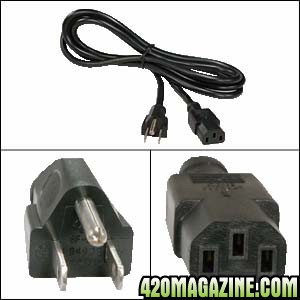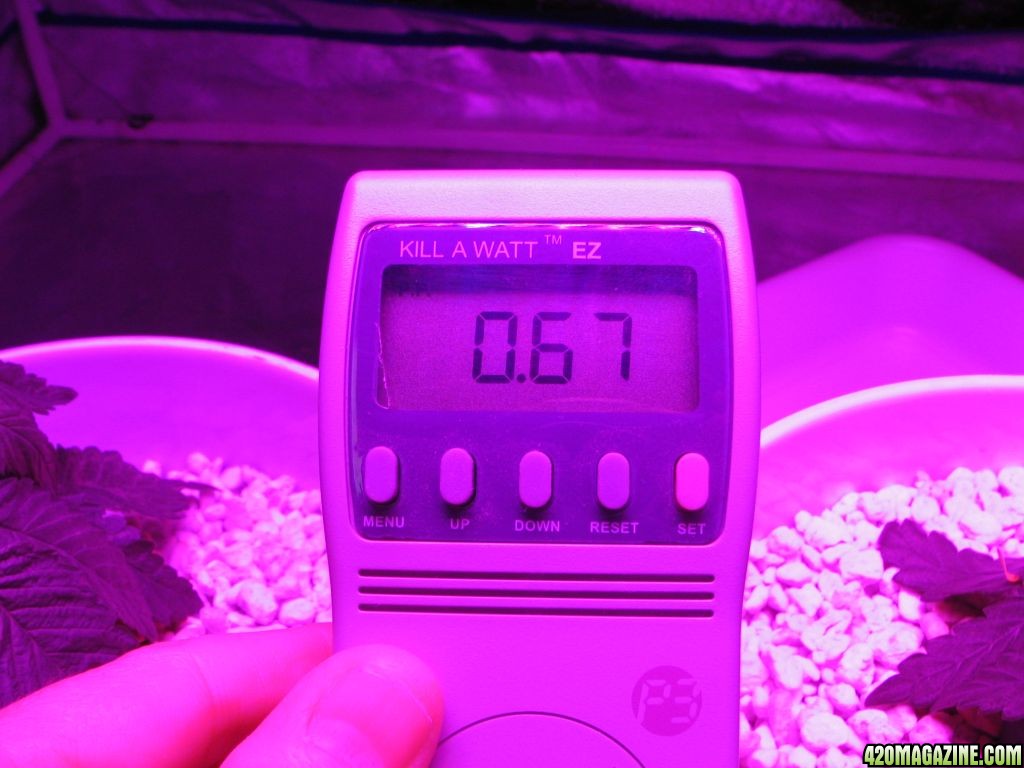Navigation
Install the app
How to install the app on iOS
How To Use Progressive Web App aka PWA On 420 Magazine Forum
Note: This feature may not be available in some browsers.
More options
You are using an out of date browser. It may not display this or other websites correctly.
You should upgrade or use an alternative browser.
You should upgrade or use an alternative browser.
EarthFireGardens 288 Watt LED Light - Munki's Experience
- Thread starter Munki
- Start date
- Thread starter
- #22
Munki, Were you the guy who said I could just get an 8' pc cord for these lights ? It would make it much easier to move the light if I had a bit more cord !! Thanks
Yes, any cord that looks like this will work. The light should only use about 2.5 amps on a 120 volt line and even the thinner PC power cords are rated for at least 10 amps. EDIT: The unit pulls 3 1/3 amps when checked with kill-a-watt meter.

If you want a longer cord, 15 feet, check out this store. It is the cheapest including shipping that I could find.
15 Foot Computer Power Cord - Black
I try to avoid unnecessary junctions on power circuits so using 1 longer cord is better than connecting a short cord to an extension cord. Even worse using that crazy adapter!
The unit pulls 3 1/3 amps when checked with kill-a-watt meter.
What voltage readings were you getting when it registered a 3.33 amp load? 120, 115, 110?
- Thread starter
- #24
You got it, my friend! I have an extra kill-a-watt meter I can use for this. I'll try and get the results up tonight.
OK, here are the results. The unit does output a low wattage, but the calculated (Volts x Amps) is significantly higher. Not sure if LEDs are inherently inefficient (don't think so), or if the analog power supply / converters are the culprit (more likely). Anyways, here are the pics.
The "wattage". This number does not mean as much to me as I am most concerned with how much electricity I'm actually using.
This is the calculated wattage in terms of volts times amperes (VA). This is what is being consumed.
This next value is the Power Factor (PF). It is calculated by watts / VA and ideally should be 1.00. We can see that only 2/3 of the energy is utilized.
Finally, here are the voltage and current (amperage) readings on the meter.
Now, the power loss noted on this unit is probably common. I know the analog ballasts used by HIDs all suffer from a low power factor. The digital ballasts for HIDs can be very efficient though. My 600 watt Quantum digital ballast has a PF of .99!

I wish I could test the other LED manufacturer lights so I could give a proper "apples to apples" comparison. Maybe others who do have these lights could go get kill-a-watt meters and submit their findings.
The Lurker
New Member
OK, here are the results. The unit does output a low wattage, but the calculated (Volts x Amps) is significantly higher. Not sure if LEDs are inherently inefficient (don't think so), or if the analog power supply / converters are the culprit (more likely). Anyways, here are the pics.
The "wattage". This number does not mean as much to me as I am most concerned with how much electricity I'm actually using.
This is the calculated wattage in terms of volts times amperes (VA). This is what is being consumed.
This next value is the Power Factor (PF). It is calculated by watts / VA and ideally should be 1.00. We can see that only 2/3 of the energy is utilized.
Finally, here are the voltage and current (amperage) readings on the meter.
Now, the power loss noted on this unit is probably common. I know the analog ballasts used by HIDs all suffer from a low power factor. The digital ballasts for HIDs can be very efficient though. My 600 watt Quantum digital ballast has a PF of .99!
Wow, thanks Munki! Very interesting indeed. That's a bit more power loss than I'd expect. TB supposedly got - what, 295w from his test unit? I wonder what his other #'s were. At least the power company's billing for real power (w, not VA), though they're applying penalties nowadays to folks with lower power factors. Bad PF's from too many people will put too much load on the power grid, and end up causing brownouts and the like. The EPA's trying to get manufacturers to comply with some degree of efficiency at your typical primary loss points:
With the rising cost of energy and concerns over the efficient delivery of power, active PFC has become more common in consumer electronics.[16] Current Energy Star guidelines for computers (ENERGY STAR® Program Requirements for Computers Version 5.0) call for a power factor of ≥ 0.9 at 100% of rated output in the PC's power supply. According to a white paper authored by Intel and the U.S. Environmental Protection Agency, PCs with internal power supplies will require the use of active power factor correction to meet the ENERGY STAR® 5.0 Program Requirements for Computers.
I wish I could test the other LED manufacturer lights so I could give a proper "apples to apples" comparison. Maybe others who do have these lights could go get kill-a-watt meters and submit their findings.
Exactly. Let's get a database of different models with at least two separate user readings each for watts (real power), VA (apparent power), amps and volts. See which panels' conversion paths are most efficent, whose are not - and who is over-compensating for putting sub-standard, low-quality/low-bin chips into them by overdriving them and burning them out faster.
At least the DIY guys have the sense to use large heat sinks and space the LEDs out more to dissipate heat if they're going to overclock them. A lot of crap out in the market now...
Thanks again,
-TL
Thats very nice but what does it all mean to some dumb ol hippy ?
(Guessing) That your electric bill might be a little bit higher than you'd expect from a first glance at the numbers? (The old joke about room-temperature superconductors, Brownian motion, and tea / no tea / tea substitute (props to The Hitchhiker's Guide to the Galaxy adventure game, lol) coming to mind.) Or... That if you're living on the ragged edge and plan your wiring/circuit runs to the edge and beyond (such as if you live in an old house with low-amp service or routinely run (well) over 80% circuit-load) you should treat devices with lower PF as if they use more wattage than they do in order to account for the increased current load?
This next value is the Power Factor (PF). It is calculated by watts / VA and ideally should be 1.00. We can see that only 2/3 of the energy is utilized.

SMPS without PFC (~.55-~.65) or one with very simplistic passive PFC (~.7-.75)? That doesn't seem to be what I'd consider an abominable number - seems like years ago computer PS were in that range. Perhaps a person could fab some kind of PFC if they so desired? Or switch to some other PS (maybe a newer computer one - although many of the ones sold are said to be... less than stellar as well)?
I wouldn't necessarily count it as a bad thing in and of itself. Well... As in all devices, there are a number of factors to consider. I haven't seen one of the PS from this product - it might be that it is not the most efficient, but is built like a tank, lol. If that were the case I'd choose it over something more efficient but less durable any day as (a) downtime in a garden light is a major bummer and (b) I wouldn't want to make a hobby out of replacing components if I didn't have to.
At this point in time I am still thinking about getting one of these lights to do a small personal grow for someone. I guess you could say that it's "on my short list."
Just rambling on...
[EDIT: The non-mechanical method of measuring PF such as (I assume is) used in that measuring device might not be all that accurate in measuring PF in such a device as an LED light. If I'm not mistaken, it's far more useful for measuring it in induction motors, refrigerators, air conditioners, and other household appliances. I could (easily) be wrong but I took a quick read through Wikipedia's (yeah, I know) page on PF and I still get that impression (but it was a QUICK read and I'm bushed, lol). Maybe one of us should email technical support at Kill-o-Watt before we place absolute trust in the numbers?
Power factor - Wikipedia ]
- Thread starter
- #28
(Guessing) That your electric bill might be a little bit higher than you'd expect from a first glance at the numbers? The old joke about room-temperature superconductors, Brownian motion, and tea / no tea / tea substitute (props to The Hitchhiker's Guide to the Galaxy adventure game, lol) coming to mind.
SMPS without PFC (~.55-~.65) or one with very simplistic passive PFC (~.7-.75)? That doesn't seem to be what I'd consider an abominable number - seems like years ago computer PS were in that range. Perhaps a person could fab some kind of PFC if they so desired? Or switch to some other PS (maybe a newer computer one - although many of the ones sold are said to be... less than stellar as well)?
I wouldn't necessarily count it as a bad thing in and of itself. Well... As in all devices, there are a number of factors to consider. I haven't seen one of the PS from this product - it might be that it is not the most efficient, but is built like a tank, lol. If that were the case I'd choose it over something more efficient but less durable any day as (a) downtime in a garden light is a major bummer and (b) I wouldn't want to make a hobby out of replacing components if I didn't have to.
Just rambling on...
[EDIT: The non-mechanical method of measuring PF such as (I assume is) used in that measuring device might not be all that accurate in measuring PF in such a device as an LED light. If I'm not mistaken, it's far more useful for measuring it in induction motors, refrigerators, air conditioners, and other household appliances. I could (easily) be wrong but I took a quick read through Wikipedia's (yeah, I know) page on PF and I still get that impression (but it was a QUICK read and I'm bushed, lol). Maybe one of us should email technical support at Kill-o-Watt before we place absolute trust in the numbers?
Power factor - Wikipedia, the free encyclopedia ]
Excellent points, TS. The power supply units are encased in a resin block for even transmission of heat and to seal against environmental attack. If one goes out on this unit, it appears only 1/12 of the LED elements will go out. Nice that its not an all or nothing proposition like with a HID ballast.
My main take on this is that the units should be advertised differently since one could reasonably assume that 288 1 watt LEDs will use around 288 watts of electricity when in actuality, it consumes much more. Once I have the ability to know what intensity is coming OUT of the unit, it will be easier to assess its true efficiency.
420
Founder
Am I the only one who saw the 420 on the box? 



The Lurker
New Member
Excellent points, TS. The power supply units are encased in a resin block for even transmission of heat and to seal against environmental attack. If one goes out on this unit, it appears only 1/12 of the LED elements will go out. Nice that its not an all or nothing proposition like with a HID ballast.
That is one of the things that has me considering one of these lights. If a HID ballast pooches on me, I know enough (and it is in fact a simple thing) to run to the nearest electrical supply house and pick up a capacitor or an ignitor (in the case of a HPS) and swap it but it's still a minor PitA - especially if it goes on the fritz on Saturday afternoon after the store has closed and I've got to wait until Monday morning and then take time off work. But with an Eco-Blaze, if one of the power-supplies goes out, I would only have to call them up and let them know and they'll ship me one right out. And in the meantime, the panel is putting out less illumination - but it IS still illuminating the garden. Things might slow, but they still grow and if the garden is in the vegetative state, there's no danger of it going into flower (or of inducing stress-related hermaphrodism). For the truly inept out there, there is of course the option of sending the light off for a repair but for almost anyone it's a fairly quick and painless job to swap a PS.
And for those that are caregivers who either grow for someone else or set up gardens for them, the fact that the light is still going to operate even if a component fails is HIGHLY important. If you're just growing for yourself, a delay - or even blowing the crop - is a pain. But if it's for someone else, it's another thing altogether.
Another thing that has Earthfire Gardens and their Eco-Blaze LEDs on my short list is that The Builder seems to treat the makers/sellers of other reputable LEDs with respect and be on good terms with them. As if they are peers in the same profession (which is as it should be). I have learned through my reading that such is not the case with every company (not mentioning any names, lol).
My main take on this is that the units should be advertised differently since one could reasonably assume that 288 1 watt LEDs will use around 288 watts of electricity when in actuality, it consumes much more. Once I have the ability to know what intensity is coming OUT of the unit, it will be easier to assess its true efficiency.
You know, I've seen discussions of this before and there have been points raised on both sides. Here is my take on it (YMMV, of course): If the LED output is ~288 watts then IMHO it should be advertised as a 288-watt light. I appreciate it if the people behind it want to tell me how many watts it's actually drawing - as The Builder has done - but we are used to dealing in terms of watts of light output. For example: Say you've got a magnetic ballasted 400-watt HPS. It outputs 400-watts (if you're lucky, lol). But the ballast uses/wastes power too. A check with your Kill-o-Watt device might show that it uses... 540 watts? Is that HPS air-cooled? If so, how many watts does the fan use? 50? Is it sold as a 590-watt HPS? Nope.
I like to be able to compare things without breaking out the slide-rule and the detective gear. While I'm (of course) interested in things such as actual power consumption, what I'm most interested in is the actual light part of the light - vis-Ã -vis the output and what it can do. An accountant might look at it differently, I suppose. But then again, maybe not - accountants are also concerned with "the bottom line."

Am I the only one who saw the 420 on the box?

That box has been around the world... You're FAMOUS, bro!

Thats very nice but what does it all mean to some dumb ol hippy ? I'm not an electrician or even close ...so can you explain in english what we should be looking for ...Thanks Munki and Lurker...I'm so confused now I think I'll look for my meds !!!
I'm with you OH! I just want to know if it can grow good pot!
TS, Your plight about an hid going out is understandable but easily remedied by having a back up ballast and bulbs ready for action. Even having the capacitor and igniter on hand prior to burnout is better than nothing.
It's just like having a back up quarterback ready to lead the team to victory when the starter goes down.
Say the unfortunate does happen and a power supply goes out. If it's under warranty how is that handled? Does Earthfire send out a replacement part and is it shipped from Hong Kong or Oregon? Does EF need to inspect and decide on fixing or replacing the light for a warranty claim?
- Thread starter
- #35
ol Hippy, just to be clear, those plants did not live their whole lives under your LED panel, so how long has it been for those pics? Plants look great for the transition from your previous light source. That's good to know in case anyone else wanted to get a LED and start using it in the middle of their grows. I don't think I've seen anyone switch to a LED when the crop was in flower though.
You have that LED on a light mover, right? So that's why some of the plant appears to be in the dark.
You have that LED on a light mover, right? So that's why some of the plant appears to be in the dark.
Munki, I started flowering 15 days ago with the LED before that they were vegging under a 400HPS the front I have 2 42 watt cfls and every couple of hours if I'm home I move the LED forward or back ,Just to insure that the whole area gets some pink light (?) but they seem to be staying even froont to back with just the added cfls for fill in front ..However if I close up the tent with just those lights the temp climbs up to the low 90s ! Door open no problem ..

Munki, I started flowering 15 days ago with the LED before that they were vegging under a 400HPS the front I have 2 42 watt cfls and every couple of hours if I'm home I move the LED forward or back ,Just to insure that the whole area gets some pink light (?) but they seem to be staying even froont to back with just the added cfls for fill in front ..However if I close up the tent with just those lights the temp climbs up to the low 90s ! Door open no problem ..
But you stated that you had just received it like 10 or 10½ days ago in this thread. And the day before you stated that you were still waiting on it.

[EDIT: Unless I'm counting wrong. You stated that you received it on the 26th of last month.]
I'd like to get an LED in the 200- to 300-watt range and attempt a grow from sprout to slaughter to see what it might do in a small personal medical grow type setup. A few of my friends are pretty interested. I haven't done much for a while and could possibly - but hopefully, NOT - pull some kind of bonehead blunder, I suppose, and as times are tough I might hit such a grow without much in the way of funds for "fancy store-bought turn-key setups" (lol) - just a good accurate pH meter, a decent EC/TDS meter, and a simple hydroponic grow more than likely. However, as a lot of potential customers might be in the same boat - perhaps not funded by a rich relative and being likely to spend the biggest portion of their initial investment on the actual LED itself... I could see (or at least rationalize to myself  ) that such a grow might be a useful demonstration to more than just myself and my friends.
) that such a grow might be a useful demonstration to more than just myself and my friends.
But I'm still at the "saving my pennies" stage, lol. I might end up having a fire-sale and seeing what I can come up with. Wish me luck, if you like (and root for the price of silver to take a sudden jump). Hopefully I can get some idea of what I'll have to work with in the next few days.
 ) that such a grow might be a useful demonstration to more than just myself and my friends.
) that such a grow might be a useful demonstration to more than just myself and my friends.But I'm still at the "saving my pennies" stage, lol. I might end up having a fire-sale and seeing what I can come up with. Wish me luck, if you like (and root for the price of silver to take a sudden jump). Hopefully I can get some idea of what I'll have to work with in the next few days.
I'd like to get an LED in the 200- to 300-watt range and attempt a grow from sprout to slaughter to see what it might do in a small personal medical grow type setup.
I'm hoping to find that out myself in a few weeks

I'm very curious about the LED's each being set in their own little reflector.
Are the LED's proprietary to that design?
How does it affect focus and intensity, and what's the lens angle on this panel?




